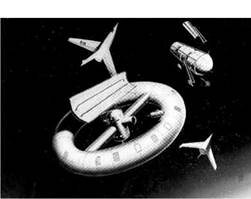1954—EHRICKE FOUR-MAN ORBITAL STATION—KRAFFT EHRICKE
In “Analysis of Orbital Systems,” a paper read at the fifth congress of the International Astronautical Federation in Innsbruck, Austria, Krafft Ehricke described an orbital station. Arguing that a very large space station was neither necessary nor desirable, Ehricke postulated a four-man design that might serve a number of different purposes, depending upon its altitude and orbital inclination. He suggested that such a station might be used for a variety of scientific research, for orbital reconnaissance, as an observation platform, and as a launch site for more distant space ventures. Later in 1958 Ehricke outlined the design for this station and called it Outpost. It would consist of an empty Atlas rocket equipped only with a pair of two-man gliders to serve as lifeboats, and could be powered by a nuclear reactor. Three further launches by Atlas-Centaur boosters would carry all of the remaining
|
|
The 1948 BIS Station
equipment required by the station. The crews would also be launched by Atlas – Centaur. Future plans called for Outpost II and III, each of which would be bigger than the last, consisting of clustered Atlas boosters, with the whole station spinning to provide artificial gravity to the occupants in either end.











